#Salesforce File Management Best Practices
Explore tagged Tumblr posts
Text
#Salesforce document management#Salesforce file management#Salesforce File Management Best Practices#Salesforce file management challenges
1 note
·
View note
Text
Top 5 Tools for Salesforce Data Migration in 2025

Data migration is a critical aspect of any Salesforce implementation or upgrade. Whether you’re transitioning from legacy systems, merging Salesforce orgs, or simply updating your current Salesforce instance, choosing the right tool can make or break the success of your migration. In 2025, the landscape of Salesforce data migration tools has evolved significantly, offering more automation, better user interfaces, and improved compatibility with complex datasets.
If you're a business looking to ensure a smooth migration process, working with an experienced Salesforce consultant in New York can help you identify the best tools and practices. Here's a detailed look at the top five Salesforce data migration tools in 2025 and how they can help your organization move data efficiently and accurately.
1. Salesforce Data Loader (Enhanced 2025 Edition)
Overview: The Salesforce Data Loader remains one of the most popular tools, especially for companies looking for a free, secure, and reliable way to manage data migration. The 2025 edition comes with a modernized UI, faster processing speeds, and enhanced error logging.
Why It’s Top in 2025:
Improved speed and performance
Enhanced error tracking and data validation
Seamless integration with external databases like Oracle, SQL Server, and PostgreSQL
Support for larger datasets (up to 10 million records)
Best For: Organizations with experienced admins or developers who are comfortable working with CSV files and need a high level of control over their data migration process.
Pro Tip: Engage a Salesforce developer in New York to write custom scripts for automating the loading and extraction processes. This will save significant time during large migrations.
2. Skyvia
Overview: Skyvia has emerged as a go-to cloud-based data integration tool that simplifies Salesforce data migration, especially for non-technical users. With drag-and-drop functionality and pre-built templates, it supports integration between Salesforce and over 100 other platforms.
Why It’s Top in 2025:
No coding required
Advanced transformation capabilities
Real-time sync between Salesforce and other cloud applications
Enhanced data governance features
Best For: Mid-sized businesses and enterprises that need a user-friendly platform with robust functionality and real-time synchronization.
Use Case: A retail company integrating Shopify, Salesforce, and NetSuite found Skyvia especially helpful in maintaining consistent product and customer data across platforms.
Expert Advice: Work with a Salesforce consulting partner in New York to set up your data models and design a migration path that aligns with your business processes.
3. Jitterbit Harmony
Overview: Jitterbit Harmony is a powerful data integration platform that enables users to design, run, and manage integration workflows. In 2025, it remains a favorite for enterprises due to its AI-powered suggestions and robust performance in complex scenarios.
Why It’s Top in 2025:
AI-enhanced mapping and transformation logic
Native Salesforce connector with bulk API support
Real-time data flow monitoring and alerts
Cross-platform compatibility (on-premise to cloud, cloud to cloud)
Best For: Large enterprises and organizations with complex IT ecosystems requiring high-throughput data migration and real-time integrations.
Tip from the Field: A Salesforce consulting firm in New York can help fine-tune your Jitterbit setup to ensure compliance with your industry regulations and data handling policies.
4. Informatica Cloud Data Wizard
Overview: Informatica is well-known in the enterprise data integration space. The Cloud Data Wizard is a lightweight, Salesforce-focused tool designed for business users. In 2025, its intuitive interface and automated field mapping make it a favorite for quick and simple migrations.
Why It’s Top in 2025:
Automatic schema detection and mapping
Pre-built Salesforce templates
Role-based access control for secure collaboration
Integration with Salesforce Flow for process automation
Best For: Companies needing quick, on-the-fly migrations with minimal IT involvement.
Case in Point: A nonprofit organization used Informatica Cloud Data Wizard for migrating donor information from spreadsheets into Salesforce Nonprofit Success Pack (NPSP) with minimal technical assistance.
Pro Insight: Partner with a Salesforce consultant in New York to evaluate whether the Cloud Data Wizard meets your scalability and security needs before committing.
5. Talend Data Fabric
Overview: Talend Data Fabric combines data integration, quality, and governance in one unified platform. In 2025, it leads the way in enterprise-grade data migration for Salesforce users who require deep customization, high security, and data lineage tracking.
Why It’s Top in 2025:
Full data quality and compliance toolset
AI-driven suggestions for data cleaning and transformation
End-to-end data lineage tracking
Integration with AWS, Azure, and Google Cloud
Best For: Industries with strict compliance needs like finance, healthcare, or government, where data accuracy and traceability are paramount.
Strategic Advantage: A Salesforce consulting partner in New York can help configure Talend’s governance tools to align with HIPAA, GDPR, or other regulatory requirements.
Why Choosing the Right Tool Matters
Data migration is more than just moving records from one system to another—it’s about preserving the integrity, security, and usability of your data. Choosing the right tool ensures:
Fewer errors and data loss
Faster deployment timelines
Higher end-user adoption
Better alignment with business goals
Partnering with Salesforce Experts in New York
Working with an experienced Salesforce consultant in New York can help you navigate the complexities of data migration. Local consultants understand both the technical and business landscapes and can offer personalized support throughout the migration journey.
Whether you're a startup looking for lean, cost-effective solutions or a large enterprise needing advanced governance, engaging with Salesforce consultants in New York ensures you make the most informed decisions.
These professionals can:
Conduct data audits and mapping
Recommend the best tool for your specific use case
Build custom scripts or integrations as needed
Ensure a smooth transition with minimal business disruption
Final Thoughts
In 2025, Salesforce data migration is no longer a cumbersome, manual task. With tools like Salesforce Data Loader, Skyvia, Jitterbit, Informatica, and Talend, businesses of all sizes can achieve fast, secure, and seamless migrations. The key lies in selecting the right tool based on your business size, technical capacity, and compliance needs.
Moreover, partnering with a knowledgeable Salesforce consulting partner in New York gives you access to tailored solutions and hands-on support, making your data migration journey smooth and successful.
Ready to migrate your data the right way? Consult with a trusted Salesforce consulting in New York expert and empower your business to scale with confidence.
#salesforce consultant in new york#salesforce consulting in new york#salesforce consulting partner in new york#salesforce consultants in new york#salesforce developer in new york#Top 5 Tools for Salesforce Data Migration in 2025
0 notes
Text
Streamline Your Workflow: A Guide to Installing WalkMe for Teams

WalkMe for Teams offers a centralised hub that brings all your work applications into one easy-to-use interface. With this tool, your organisation can provide employees with tailored access to important resources and improve overall productivity. This guide explains the steps required to install WalkMe for Teams, ensuring a smooth deployment by your IT department.
Preparing for Installation
Before beginning the installation, ensure that your IT department is ready to manage the process. WalkMe for Teams is designed to be deployed via the Teams admin centre rather than by individual users. This centralised approach means your organisation maintains control over app distribution and customisation. Begin by accessing the Microsoft Teams admin centre at https://admin.teams.microsoft.com/policies/app-setup.
Setting Up the App Policy
The first step is to create an app setup policy:
Sign in to the Teams admin centre: Once logged in, navigate to Teams apps > Setup policies.
Add a new policy: Click on Add and provide a clear name and description for the policy.
Include WalkMe in Installed Apps: Under the Installed apps section, select Add apps. In the search pane, type “WalkMe” and then click Add to include it in the policy.
Pin the App for Better Engagement: Scroll down to the Pinned apps section, click Add apps, search for “WalkMe”, and then click Add. For optimal user engagement, reposition the WalkMe app higher on the pinned apps list.
Assigning the Policy to Users
After configuring the app policy, the next step is to decide which user groups will receive the WalkMe app:
Return to the policies page: Go back to https://admin.teams.microsoft.com/policies/app-setup.
Group Policy Assignment: Select Group policy assignment > Add. Choose the appropriate Azure AD group. For organisations covering all employees, select a group that represents the entire company.
Apply the Policy: After selecting the group, choose the newly created policy from the list and click Apply.
Creating an Azure AD Group
To ensure that all relevant users are included:
Log in to Azure AD: Visit https://portal.azure.com/ and click on Groups.
Create a New Group: Choose New Group, set the group type to Security, and provide a name and description.
Set Membership to Dynamic User: Select Dynamic user as the membership type and add a dynamic query. For example, use the condition where “userPrincipalName” Contains “@YOUR_DOMAIN.COM”. Replace YOUR_DOMAIN with your actual domain name.
Save and Wait: After saving the query, the group will populate with all users matching the criteria.
Customisation and Branding
WalkMe for Teams is adaptable to your organisation's branding:
Short Name and Full Name: Update these in the manifest file to display the appropriate names for your tab.
Icons: Replace the default icon files with your custom PNG files. Ensure that the icon dimensions meet Microsoft’s guidelines.
Additional Resources and Support
For further guidance on customisations and best practices, check out the experiences shared by our WalkMe partner Australia. If you need assistance with other Teams configurations, refer to resources available at WalkMe microsoft teams. Reading through WalkMe customer stories can provide real-world examples of successful deployments and benefits realised by other organisations.
Final Thoughts
By following this guide, your IT department can install WalkMe for Teams with confidence. This process creates a centralised hub that simplifies access to applications and resources, supporting digital adoption and boosting overall productivity. Enjoy a smoother, more streamlined work experience with WalkMe for Teams.
The author is a digital adoption expert with deep insights into enterprise systems, user engagement, and practical deployment strategies. Their expertise spans platform comparisons, installation guides, and best practices for tools like WalkMe, Salesforce, and ERP solutions. For expert digital adoption solutions, visit: https://www.guidemesolutions.com/
0 notes
Text
Using Azure Data Factory for Government Data Pipelines

Introduction
Government agencies handle vast amounts of data, ranging from citizen records and tax information to law enforcement and healthcare data. Managing, processing, and integrating such data securely and efficiently is a significant challenge.
Azure Data Factory (ADF) provides a scalable, cloud-based ETL (Extract, Transform, Load) solution that enables government agencies to securely move and transform data while ensuring compliance with regulatory requirements. This blog explores how ADF can be leveraged for government data pipelines, key features, and best practices for secure data processing.
Why Azure Data Factory for Government Data?
1. Compliance with Government Regulations
Government agencies must adhere to strict data security and compliance requirements such as:
FedRAMP (Federal Risk and Authorization Management Program)��— Ensuring cloud security for U.S. government agencies
GDPR (General Data Protection Regulation) — Protecting personal data of EU citizens
HIPAA (Health Insurance Portability and Accountability Act) — For handling healthcare data
CJIS (Criminal Justice Information Services) Compliance — Data protection for law enforcement agencies
Azure Data Factory supports compliance by offering role-based access control (RBAC), encryption, audit logging, and private network security to safeguard sensitive government data.
2. Secure and Scalable Data Movement
Government agencies often have hybrid infrastructures with data spread across on-premises servers, legacy systems, and cloud platforms. ADF facilitates seamless data movement and transformation across these environments while maintaining security through:
Self-Hosted Integration Runtimes for secure on-premises data access
Private Link to restrict network exposure
Built-in encryption (both at rest and in transit)
3. Integration with Multiple Data Sources
ADF supports integration with a wide range of structured and unstructured data sources, including:
SQL Server, Oracle, PostgreSQL (On-Premises and Cloud)
Azure Blob Storage, Azure Data Lake Storage
REST APIs, SAP, Salesforce, and more
This flexibility enables government agencies to centralize disparate datasets, ensuring seamless interoperability.
Key Features for Government Data Pipelines
1. Secure Data Integration
ADF enables secure data ingestion from multiple sources while enforcing access policies. Data transformation can be performed within Azure Synapse Analytics, Databricks, or other processing engines, ensuring compliance with government security standards.
2. Data Security & Governance
Managed Private Endpoints — Ensuring data does not traverse the public internet
Azure Policy & RBAC — Controlling who can access and manage data pipelines
Data Masking & Encryption — Protecting personally identifiable information (PII)
3. Automated Workflows & Monitoring
Government agencies require scheduled and event-driven data workflows for regulatory reporting and citizen services. ADF provides:
Triggers and Scheduling for automated ETL workflows
Monitoring & Logging with Azure Monitor for real-time visibility
Alerts & Notifications for pipeline failures
4. Hybrid Connectivity for Legacy Systems
Government organizations often rely on legacy systems that need modernization. ADF allows secure connectivity to on-premises databases and file servers using self-hosted integration runtimes, ensuring smooth data migration and transformation.
Use Cases of ADF in Government Data Processing
1. Citizen Services & Public Portals
Government portals require real-time data processing for services like tax filings, unemployment claims, and benefits distribution. ADF enables:
Data ingestion from APIs and databases for up-to-date citizen information
Data validation and transformation for accurate reporting
Integration with Power BI for visual analytics and dashboards
2. Regulatory Compliance & Auditing
Agencies must comply with data retention, auditing, and security policies. ADF helps:
Automate compliance checks by monitoring data movements
Ensure audit logs are stored securely in Azure Storage or Data Lake
Apply data masking to protect sensitive records
3. Law Enforcement & Security Data Processing
ADF helps police and security agencies manage and analyze large volumes of crime records, surveillance footage, and biometric data by:
Extracting data from multiple sources (CCTV, databases, IoT sensors)
Transforming and analyzing crime patterns using Azure Synapse
Ensuring strict access controls and encryption
4. Healthcare & Public Welfare Data Pipelines
Government healthcare agencies need to process large volumes of patient records, medical claims, and research data. ADF can:
Integrate hospital databases with public health systems
Anonymize sensitive healthcare data for research purposes
Enable real-time processing of pandemic-related data
1. Implement Private Links and Managed Virtual Networks
Use Azure Private Link to connect ADF securely to Azure resources
Set up Managed Virtual Networks to restrict data pipeline access
2. Use Azure Policy for Governance
Enforce RBAC policies to limit data access
Automate compliance monitoring to detect unauthorized data movements
3. Encrypt Data at Rest and in Transit
Utilize Azure Key Vault for managing encryption keys
Enable TLS encryption for all data transmissions
4. Set Up Data Masking & Row-Level Security
Apply dynamic data masking to protect sensitive information
Implement row-level security to restrict access based on user roles
5. Automate Compliance Checks with Azure Monitor
Use Azure Monitor & Log Analytics to track ADF pipeline activities
Set up alerts for anomalies to detect potential security threats
Conclusion
Azure Data Factory provides a powerful solution for secure, scalable, and compliant data pipelines in government agencies. By leveraging ADF’s integration capabilities, security features, and automation tools, agencies can modernize their data workflows while ensuring regulatory compliance.
Adopting Azure Data Factory for government data pipelines can enhance data security, operational efficiency, and citizen services, making data-driven decision-making a reality for public institutions.
WEBSITE: https://www.ficusoft.in/azure-data-factory-training-in-chennai/
0 notes
Text
A Complete Guide to Oracle Fusion Technical and Oracle Integration Cloud (OIC)
Oracle Fusion Applications have revolutionized enterprise resource planning (ERP) by providing a cloud-based, integrated, scalable solution. Oracle Fusion Technical + OIC Online Training is crucial in managing, customizing, and extending these applications. Oracle Integration Cloud (OIC) is a powerful platform for connecting various cloud and on-premises applications, enabling seamless automation and data exchange. This guide explores the key aspects of Oracle Fusion Technical and OIC, their functionalities, and best practices for implementation.
Understanding Oracle Fusion Technical
Oracle Fusion Technical involves the backend functionalities that enable customization, reporting, data migration, and integration within Fusion Applications. Some core aspects include:
1. BI Publisher (BIP) Reports
BI Publisher (BIP) is a powerful reporting tool that allows users to create, modify, and schedule reports in Oracle Fusion Applications. It supports multiple data sources, including SQL queries, Web Services, and Fusion Data Extracts.
Features:
Customizable templates using RTF, Excel, and XSL
Scheduling and bursting capabilities
Integration with Fusion Security
2. Oracle Transactional Business Intelligence (OTBI)
OTBI is a self-service reporting tool that provides real-time analytics for business users. It enables ad-hoc analysis and dynamic dashboards using subject areas.
Key Benefits:
No SQL knowledge required
Drag-and-drop report creation
Real-time data availability
3. File-Based Data Import (FBDI)
FBDI is a robust mechanism for bulk data uploads into Oracle Fusion Applications. It is widely used for migrating data from legacy systems.
Process Overview:
Download the predefined FBDI template
Populate data and generate CSV files
Upload files via the Fusion application
Load data using scheduled processes
4. REST and SOAP APIs in Fusion
Oracle Fusion provides REST and SOAP APIs to facilitate integration with external systems.
Use Cases:
Automating business processes
Fetching and updating data from external applications
Integrating with third-party tools
Introduction to Oracle Integration Cloud (OIC)
Oracle Integration Cloud (OIC) is a middleware platform that connects various cloud and on-premise applications. It offers prebuilt adapters, process automation, and AI-powered insights to streamline integrations.
Key Components of OIC:
Application Integration - Connects multiple applications using prebuilt and custom integrations.
Process Automation - Automates business workflows using structured and unstructured processes.
Visual Builder - A low-code development platform for building web and mobile applications.
OIC Adapters and Connectivity
OIC provides a wide range of adapters to simplify integration:
ERP Cloud Adapter - Connects with Oracle Fusion Applications
FTP Adapter - Enables file-based integrations
REST/SOAP Adapter - Facilitates API-based integrations
Database Adapter - Interacts with on-premise or cloud databases
Implementing an OIC Integration
Step 1: Define Integration Requirements
Before building an integration, determine the source and target applications, data transformation needs, and error-handling mechanisms.
Step 2: Choose the Right Integration Pattern
OIC supports various integration styles, including:
App-Driven Orchestration - Used for complex business flows requiring multiple steps.
Scheduled Integration - Automates batch processes at predefined intervals.
File Transfer Integration - Moves large volumes of data between systems.
Step 3: Create and Configure the Integration
Select the source and target endpoints (e.g., ERP Cloud, Salesforce, FTP).
Configure mappings and transformations using OIC’s drag-and-drop mapper.
Add error handling to manage integration failures effectively.
Step 4: Test and Deploy
Once configured, test the integration in OIC’s test environment before deploying it to production.
Best Practices for Oracle Fusion Technical and OIC
For Oracle Fusion Technical:
Use OTBI for ad-hoc reports and BIP for pixel-perfect reporting.
Leverage FBDI for bulk data loads and REST APIs for real-time integrations.
Follow security best practices, including role-based access control (RBAC) for reports and APIs.
For Oracle Integration Cloud:
Use prebuilt adapters whenever possible to reduce development effort.
Implement error handling and logging to track failures and improve troubleshooting.
Optimize data transformations using XSLT and built-in functions to enhance performance.
Schedule integrations efficiently to avoid API rate limits and performance bottlenecks.
Conclusion
Oracle Fusion Technical and Oracle Integration Cloud (OIC) are vital in modern enterprise applications. Mastering these technologies enables businesses to create seamless integrations, automate processes, and generate insightful reports. Organizations can maximize efficiency and drive digital transformation by following best practices and leveraging the right tools.
Whether you are an IT professional, consultant, or business user, understanding Oracle Fusion Technical and OIC is essential for optimizing business operations in the cloud era. With the right approach, you can harness the full potential of Oracle’s powerful ecosystem.

0 notes
Text
Salesforce DevOps Online Training | Salesforce DevOps Course
What Challenges Does Copado Solve in Salesforce DevOps Pipelines?
Salesforce DevOps Training world of Salesforce development, implementing effective DevOps practices is essential for delivering high-quality applications efficiently. However, teams often encounter several challenges unique to the Salesforce ecosystem. Copado, a leading Salesforce-native DevOps platform, offers solutions to these challenges, streamlining development and deployment processes.
Challenges in Salesforce DevOps Pipelines
Siloed Development and Operations Teams
Traditionally, development and operations teams in Salesforce environments operate in silos, leading to fragmented workflows and hindered collaboration. This disconnect can cause misaligned priorities, deployment delays, and increased error ratesSalesforce DevOps Course.
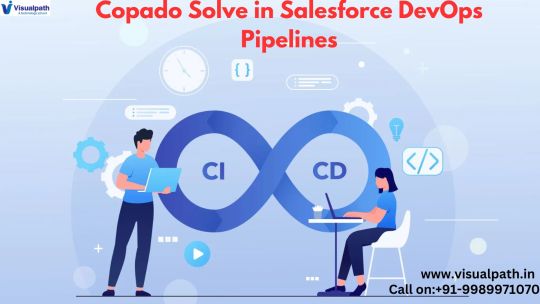
Complexity with Salesforce Metadata
Salesforce's metadata-driven architecture presents challenges such as:
Component behavior split across multiple files (e.g., Profiles, Layouts).
Unsupported metadata types.
Inconsistent modification timestamps for certain metadata (e.g., Value Sets).
Numerous manual steps required in deployments.
These complexities can lead to deployment errors and increased manual effort.
Version Control and Source Code Management
Many Salesforce teams are not accustomed to version control systems, leading to challenges such as:
Complexity with merges and back-merges.
Conflict resolution in large objects and Profiles during heavy-duty merges.
This can result in difficulties tracking changes, collaborating effectively, Salesforce DevOps Certification and maintaining code integrity.
Continuous Integration and Deployment (CI/CD)
Implementing effective CI/CD practices in Salesforce development can be daunting due to:
Complex customizations and configurations.
Challenges in ensuring pipeline stability and reliability.
Without proper CI/CD processes, teams may face delays in identifying bugs, lower confidence in code changes, and a higher risk of regression issues.
Test Automation and Code Quality
Ensuring high code quality and implementing comprehensive test automation are critical yet challenging aspects of Salesforce DevOps. Manual testing can be time-consuming and error-prone, while maintaining code quality becomes more difficult as projects grow in size and complexity.
How Copado Addresses These Challenges
Enhancing Collaboration Between Teams
Salesforce DevOps with Copado Training fosters collaboration by providing a unified platform where development and operations teams can work together seamlessly. Features like user stories, pipelines, and automated deployments ensure that all stakeholders are aligned, reducing silos and improving communication.
Simplifying Metadata Management
Copado simplifies metadata management by:
Providing a comprehensive view of all metadata components.
Automating the retrieval and deployment of metadata.
Handling complex dependencies and unsupported metadata types.
This reduces manual steps and minimizes errors during deployments.
Streamlining Version Control
Copado integrates with version control systems like Git, offering:
User-friendly interfaces for managing branches and merges.
Automated conflict detection and resolution assistance.
Visualization tools to track changes and history.
This makes version control more accessible to Salesforce teams, enhancing collaboration and code integrity.
Implementing Robust CI/CD Pipelines
Copado enables the creation of robust CI/CD pipelines by:
Automating builds and deployments across multiple environments.
Integrating automated testing to catch issues early.
Providing rollback mechanisms to ensure stability.
This accelerates release cycles and ensures high-quality deployments.
Enhancing Test Automation and Code Quality
Copado improves test automation and code quality by:
Integrating with testing frameworks to automate test execution.
Enforcing code quality checks and best practices.
Providing dashboards to monitor test results and code metrics.
This ensures that only high-quality code reaches production, reducing defects and technical debt.
Conclusion
Copado addresses the unique challenges of Salesforce DevOps by enhancing collaboration, simplifying metadata management, streamlining version control, implementing robust CI/CD pipelines, and improving test automation and code quality. By leveraging Copado, organizations can achieve more efficient, reliable, and scalable Salesforce development and deployment processes.
Visualpath is the Leading and Best Software Online Training Institute in Hyderabad. Avail complete Salesforce DevOps Course Worldwide. You will get the best course at an affordable cost.
Attend Free Demo
Call on - +91-9989971070.
WhatsApp: https://www.whatsapp.com/catalog/919989971070/
Visit: https://www.visualpath.in/online-salesforce-devops-training.html
Visit Blog: https://salesforcedevopscourseonlinetraining.blogspot.com/
#Salesforce DevOps Training#Salesforce DevOps Course#Salesforce DevOps Certification#Salesforce DevOps Online Training#Salesforce DevOps Training In Hyderabad#Salesforce DevOps With Copado Training#Salesforce DevOps Online Training Hyderabad#Salesforce DevOps Online Courses
0 notes
Text
Essential Tools for Streamlining Your Client Onboarding Process

1. CRM Tools for Centralized Client Management
Customer Relationship Management (CRM) tools like HubSpot, Salesforce, and Zoho CRM are indispensable for managing client information effectively. These tools help:
Organize client contact details and communication history.
Set up automated follow-ups and reminders.
Track the status of onboarding tasks.
By using a CRM, your PPC services team in Pune can maintain a centralized system, ensuring that no client details are overlooked during onboarding.
2. Project Management Tools
Platforms like Trello, Asana, or Monday.com streamline task assignment and tracking. For a PPC agency, these tools can be used to:
Create detailed onboarding checklists.
Assign tasks to specific team members, such as account setup or keyword research.
Monitor progress in real time.
These tools ensure that all onboarding activities are completed promptly and systematically.
3. Proposal and Contract Management Software
Using tools like PandaDoc or DocuSign simplifies the creation and signing of contracts. Key features include:
Customizable templates for proposals and agreements.
E-signature capabilities for faster approvals.
Real-time tracking of document status.
With these tools, your PPC services team can reduce delays and ensure all formalities are completed efficiently.
4. Communication Platforms
Effective communication is the cornerstone of a smooth onboarding process. Tools like Slack, Microsoft Teams, or Zoom enable real-time collaboration by offering:
Instant messaging for quick queries.
Video conferencing for detailed discussions.
Channels dedicated to specific clients or projects.
These platforms keep communication transparent and ensure that clients feel involved from the start.
5. Data Collection and Reporting Tools
Collecting relevant data is critical during onboarding to create effective PPC campaigns. Tools like Google Forms, Typeform, or Jotform help gather:
Business goals and target audience details.
Budget preferences and campaign objectives.
Login credentials for ad platforms.
This ensures your PPC services in Pune are customized to meet each client’s unique requirements.
6. Advertising Platform Setup Guides
Onboarding often involves setting up or auditing ad accounts. Tools like Google Ads Editor or Facebook Business Suite streamline account setup and campaign management. They allow you to:
Verify proper account configurations.
Set up billing information.
Optimize ad account settings based on industry best practices.
Ensuring these setups are flawless minimizes errors and enhances campaign performance.
7. File Sharing and Collaboration Tools
Tools like Google Drive, Dropbox, or OneDrive make it easy to share important documents and creative assets with clients. Features include:
Secure storage for sensitive information.
Real-time editing and collaboration.
Easy access to files from any device.
These tools keep all parties on the same page, ensuring transparency and efficiency.
8. Analytics and Reporting Tools
To build trust with clients, offer clear insights into campaign performance from day one. Tools like Google Analytics, SEMrush, or Supermetrics provide:
Initial performance benchmarks.
Customized dashboards tailored to client needs.
Regular reporting to track campaign success.
Your PPC services in Pune can stand out by showcasing professionalism and data-driven decision-making during onboarding.
9. Training and Knowledge-Sharing Platforms
Educating clients about PPC strategies can foster collaboration. Tools like Loom or Thinkific help create and share:
Introductory videos explaining PPC concepts.
Tutorials on accessing reports and dashboards.
Guides for providing constructive feedback
These tools empower clients, making them feel more confident about their investment in your PPC services.
10. Automated Workflows
Automation tools like Zapier or Make (formerly Integromat) can connect various platforms, reducing manual effort. For example:
Automatically add client details from forms to your CRM.
Notify team members of new onboarding tasks.
Trigger follow-up emails to clients post-onboarding.
Automation saves time, allowing your team to focus on delivering exceptional PPC services in Pune.
Conclusion
An efficient onboarding process sets the tone for a successful partnership. By leveraging the right tools, you can ensure that your PPC services are delivered seamlessly, building trust and long-term client relationships. As a trusted provider of PPC services in Pune, Digital Rhetoric is dedicated to optimizing every aspect of the client experience. From onboarding to campaign execution, we use cutting-edge tools to deliver unparalleled results.
Ready to streamline your PPC campaigns? Visit our dedicated page: PPC Services in Pune and let’s take your business to new heights!
0 notes
Text
The Future of Cloud App Development: Unlocking Business Value
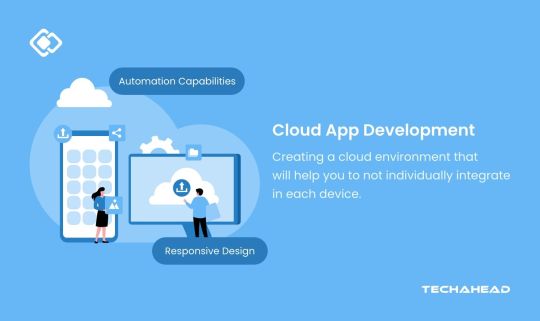
Cloud computing is rapidly transforming businesses. Many industry reports reveal that as business mobile applications grow, over 70% of digital workspaces face challenges with storage capacity and performance. The ideal solution to these issues is cloud app development, which provides unmatched scalability and flexibility.
Cloud app development simplifies data collection, enabling businesses to gather insights faster and more efficiently. It also enhances data security and streamlines management, making compliance and administration less burdensome. Cloud-powered development solutions empower businesses to create high-performance, productivity-focused applications that drive customer satisfaction and boost revenue.
Furthermore, cloud software solutions support low-code development, a time- and cost-efficient approach that minimizes extensive coding. This allows businesses to launch applications faster, optimizing resource usage and accelerating innovation cycles.
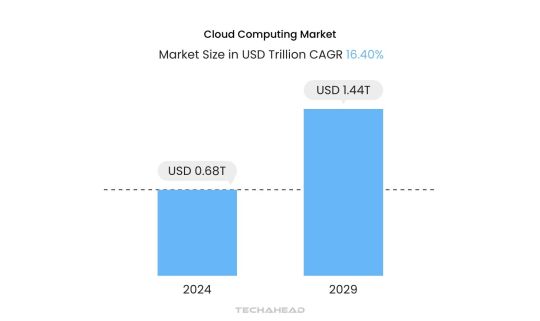
The cloud computing market is projected to grow substantially, with an estimated size of USD 0.68 trillion in 2024, anticipated to reach USD 1.44 trillion by 2029 at a CAGR of 16.40% (source: Mordor Intelligence). This robust growth highlights the rising demand for cloud solutions across industries. However, this rapid expansion in cloud applications prompts critical questions for businesses, especially around best practices in cloud app development.
In this guide, we’ll explore how to approach cloud app development effectively, the diverse cloud-based application solutions available, and how they drive value. You’ll gain insights into creating cloud applications that enhance operational efficiency, scalability, and customer engagement.
Let’s begin by examining the essentials that pave the way for efficient and future-ready cloud app development.
What is Cloud App Development?
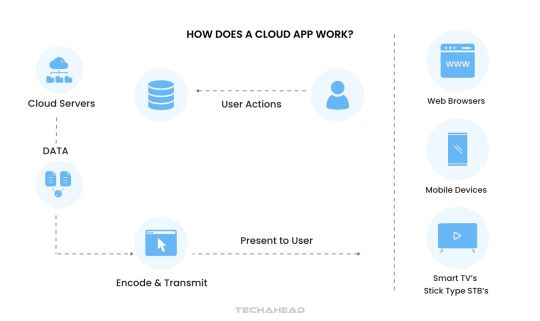
Cloud app development refers to creating applications within a cloud environment, bypassing the need for local servers. Unlike native applications, cloud-based apps rely extensively on cloud app development services, including data storage and processing, making them accessible through web browsers and other online platforms.
As enterprise development grows more reliant on cloud capabilities, they have leveraged its computational power to build groundbreaking solutions, transforming what’s possible in technology. Cloud services now empower companies to create a vast range of cloud applications that operate seamlessly on the web, often known as web apps.
These cloud apps are reshaping various business functions, taking over essential tasks like email, word processing, file storage, data collection, and even financial accounting. Through cloud app development, organizations are equipped with efficiency, streamline operations, and scale solutions like never before.
Types of Cloud App Development
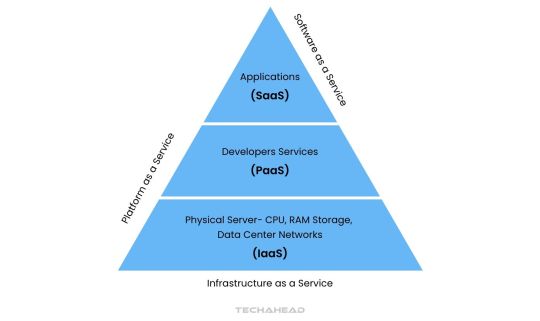
Software-as-a-Service (SaaS)
SaaS applications are hosted and maintained entirely by a cloud provider, making them accessible via the internet through web browsers. These applications relieve businesses from handling updates, server management, and software installations, as all maintenance is centrally managed by the provider. Users can seamlessly access features, integrate productivity tools, and share data across teams, which enhances operational efficiency.
Solutions like Google Workspace, Salesforce, and Slack exemplify SaaS by providing essential tools for collaboration, sales, and project management within a single, easily accessible platform.
Platform-as-a-Service (PaaS)
PaaS offers a managed environment for application development, which includes tools for building, testing, and deploying software while the cloud provider oversees infrastructure. By managing hardware and backend services, PaaS enables development teams to focus solely on cloud app development without the burden of configuring servers or databases. This platform accelerates time-to-market and streamlines scaling since the underlying resources are automatically adjusted as demand increases.
Examples like Microsoft Azure App Services and Google App Engine give developers robust frameworks and APIs, helping them build complex applications with minimal operational overhead.
Infrastructure-as-a-Service (IaaS)
IaaS delivers essential computing infrastructure such as virtual servers, storage, and networking resources. Unlike traditional on-premises infrastructure, IaaS allows businesses to pay for only the resources they use, which is ideal for scaling and managing large workloads flexibly. This model offers extensive control over the infrastructure, enabling IT teams to customize their environments and manage systems as needed.
Leading providers like AWS, Azure, and Google Cloud Platform provide services that allow companies to extend, scale, and secure their infrastructure easily, aligning with cloud app development needs for flexibility and resilience.
Function-as-a-Service (FaaS)
FaaS is part of serverless computing, allowing developers to deploy discrete code functions triggered by specific events, like user actions or system updates. With FaaS, there’s no need to manage or scale servers manually; the cloud provider handles it automatically based on demand. This model is ideal for applications requiring quick responses to high volumes of concurrent events, as it enhances cost efficiency and operational simplicity.
Popular FaaS services include AWS Lambda and Google Cloud Functions, which cater to cloud app development that prioritizes lightweight, highly scalable, and event-driven functionality.
Container-as-a-Service (CaaS)
CaaS leverages containers—lightweight, portable units of software that package application code along with its dependencies—for more efficient deployment and scaling across different environments. This model is highly beneficial for businesses adopting microservices architectures, as containers improve consistency in app deployment from development to production. CaaS platforms utilize orchestration tools, like Kubernetes, to automate the deployment, scaling, and management of containerized applications across multiple cloud or on-premises environments.
CaaS aligns with cloud app development demands for agility, allowing applications to scale seamlessly across hybrid or multi-cloud setups without compatibility issues.
Features of Every Cloud App Development Should Have
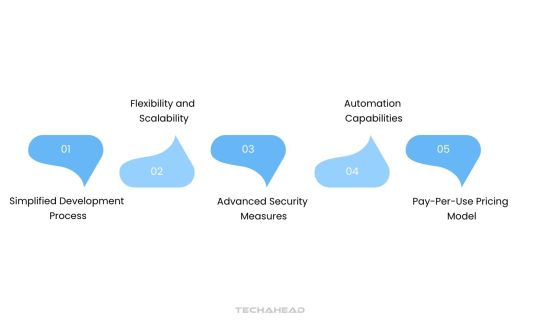
Simplified Development Process
An effective cloud app development platform should prioritize speed and simplicity. It should streamline architectural decisions, reducing complexity in creating and deploying applications across diverse technical environments. This simplicity allows hired developers to address challenges faster, minimizing errors and accelerating deployment. An efficient platform optimizes the overall development workflow, making it seamless to launch applications that meet high standards across various infrastructures.
Flexibility and Scalability
In cloud app development, flexibility is paramount. A robust platform should allow users to easily scale resources—adding or removing computing power, storage, and networking assets as demands fluctuate. Through automated scaling, these platforms adapt to dynamic workloads, preventing bottlenecks while ensuring optimal performance. During peak demand, a well-configured platform should instantly increase resources, and when demand lessens, it should scale down, maximizing cost-efficiency and resource allocation.
Advanced Security Measures
Security in cloud app development is a core feature, as cloud platforms employ top-tier security experts dedicated to threat management. These platforms adhere to stringent security protocols, often exceeding the protection provided by in-house teams. With compliance measures integrated, organizations can meet industry and governmental regulations effortlessly. Notably, 91% of companies report improved regulatory compliance post-cloud migration, emphasizing the cloud’s ability to safeguard data and ensure confidentiality.
You can also learn about the pillars of AI security and how it is protecting future technology.
Automation Capabilities
Automated processes are vital for managing complex, repetitive tasks in cloud app development. Advanced platforms support continuous integration and resource orchestration, which reduce operational burdens. Automation tools manage workload scaling, ensuring resources are available when needed without manual intervention. This allows IT teams to support growing demands efficiently while concentrating on strategic initiatives, enhancing overall operational efficiency.
Pay-Per-Use Pricing Model
A pay-per-use model enhances cost control within cloud app development, as users only pay for what they consume. This approach eliminates unnecessary expenses, allowing businesses to scale resources economically. Cloud providers track and report usage metrics, helping users monitor and optimize expenses. Some providers also offer a base level of free storage or computing power, making cloud resources even more accessible for startups and small businesses.
Steps to Take While Developing a Cloud App
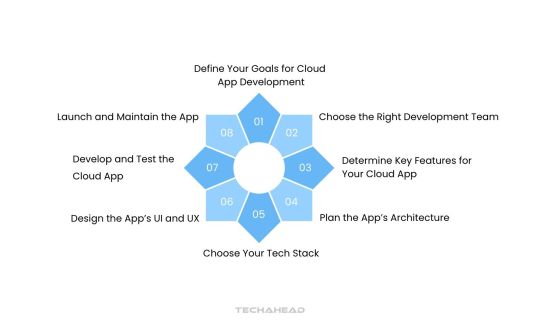
Creating a cloud app can involve web or mobile solutions, with the required technologies varying by solution type. Despite technical differences, the fundamental process in cloud app development follows similar phases to build a robust, user-centered application.
Step 1: Define Your Goals for Cloud App Development
Establishing clear objectives is crucial before development begins. Align all stakeholders on the project’s vision and goals during the discovery phase, helping the team understand the core business needs.
Reasons to consider cloud app development include:
Workflow automation: Streamlining repetitive tasks saves time and resources
Centralized data storage: Access and manage data easily within a single, organized environment.
Enhanced team collaboration: Improve internal communication and ensure seamless data exchanges.
Advanced reporting and analytics: Gain valuable insights to drive data-based decisions.
The discovery phase also allows developers to identify project scope, complexities, potential challenges, and costs. If a swift market entry is critical, a Minimum Viable Product (MVP) may be the best first step.
Step 2: Choose the Right Development Team
Cloud app development requires specialized skills, so selecting the right development team is essential. You can opt for freelancers, in-house talent, or outsource to a software development company.
Choosing a reliable cloud app development partner ensures ongoing support as the app evolves. Here are some questions to assess potential developers:
Can you share similar cloud app projects you have handled?
What platforms and technologies are you skilled in?
How do you prioritize security and scalability in development?
How do you approach cost management for cloud resources?
Can you ensure effective collaboration throughout the project?
A reliable development partner can adapt the app as technology advances and business needs grow.
Step 3: Determine Key Features for Your Cloud App
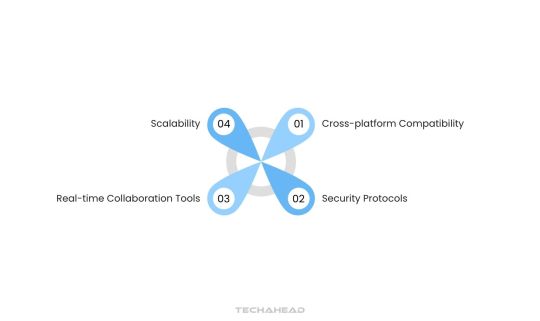
Identify core features that create a user-friendly experience in cloud applications. Essential features include:
Cross-platform compatibility: Allow users to access the app on their preferred devices.
Security protocols: Implement logins and access controls to protect user data.
Real-time collaboration tools: Enable users to work together through features like chat, live comments, and shared documents.
Scalability: Ensure the app can handle increasing users or workload.
Incorporating these features enhances user satisfaction and engagement, setting your app up for success.
Step 4: Plan the App’s Architecture
Your app’s architecture is the backbone of cloud app development, influencing scalability, security, and cost efficiency. Choose an architecture that aligns with your project’s requirements.
Key options include:
Monolithic architecture: A single, interconnected application; easy to develop but challenging to scale.
Microservices architecture: Divides the app into independent services; highly scalable but may face performance trade-offs.
Serverless architecture: Uses event-triggered functions in a serverless environment, ideal for low-maintenance, scalable solutions.
Hybrid architecture: Combines on-premises and cloud resources for high flexibility but may involve integration complexities.
Select an architecture that best aligns with your cloud app development goals. You can also look into this guide on Serverless Vs. Microservices architecture.
Step 5: Choose Your Tech Stack
The technology stack determines how quickly, securely, and effectively the app functions. Different projects require different combinations of programming languages (e.g., Java, Python, Node.js), databases (e.g., MongoDB, Firebase), frameworks (e.g., React, Angular), and containers (e.g., Docker, Kubernetes).
For instance, a Python-based stack offers scalability and maintenance ease, while Ruby on Rails works well for prototyping and collaboration. Choose the right tech stack that aligns with your app’s performance and integration needs.
Step 6: Design the App’s User Interface (UI) and User Experience (UX)
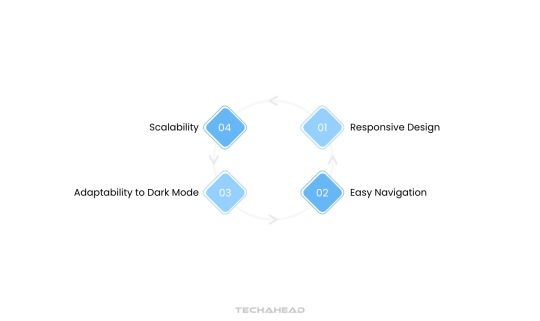
Effective UI/UX design is vital in cloud app development to create intuitive and visually appealing apps. Consider these elements:
Responsive design: Ensure seamless functionality across platforms and screen sizes.
Easy navigation: Users should quickly find what they need with minimal guidance.
Adaptability to dark mode: Offer both light and dark modes to reduce eye strain.
Scalability: Design a UI that accommodates future growth and additional features.
A responsive, intuitive, and adaptable UI makes the app user-friendly and future-proof. You can learn more about the Mobile UI designs as well.
Step 7: Develop and Test the Cloud App
Cloud app development typically uses Agile or DevOps methodologies, depending on project needs and team preferences.
Agile development emphasizes short, iterative development cycles, with regular testing and feedback after each sprint. Agile promotes flexibility, allowing the team to adapt to evolving requirements.
DevOps fosters collaboration across development and operations, with a focus on Continuous Integration/Continuous Delivery (CI/CD) and automation for efficient testing and deployment.
Both approaches streamline development, but the choice depends on team readiness and project goals.
Step 8: Launch and Maintain the App
Successful cloud app development doesn’t end with deployment. Continuous maintenance keeps your app relevant, responsive, and secure. Essential areas include:
Security updates: Regular patches to safeguard user data.
Performance optimization: Keep the app fast and responsive as usage grows.
Scalability adjustments: Ensure the app scales efficiently as demand fluctuates.
Technology updates: Adapt the stack to new versions or libraries.
Ongoing maintenance ensures a secure, scalable, and high-performing cloud app that keeps pace with technological advancements and user expectations.
Benefits of Cloud App Development
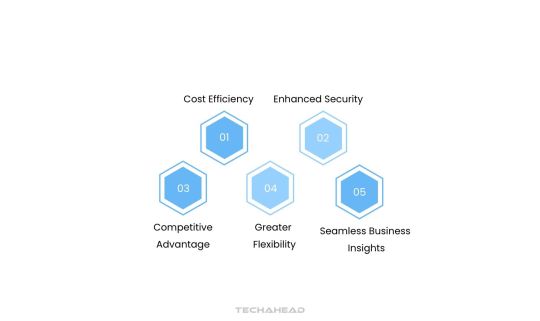
Cost Efficiency
Cloud app development significantly reduces costs by eliminating the need for on-premise infrastructure. With cloud-based applications, businesses only pay for the services they use, making it approximately 40% more affordable for small companies. This pay-as-you-go model means businesses can adjust monthly expenses based on usage, resulting in ongoing cost control.
Unlike traditional hardware, which requires significant upfront investment, cloud solutions offer flexible pricing that can scale with business growth. Additionally, many providers offer cost-saving options, like discounts on long-term contracts for larger enterprises.
You can learn more about the cost of app development.
Enhanced Security
Data security remains a huge priority when it comes to cloud app development. While integrating them, they tend to provide robust protection that safeguards sensitive information. Top cloud-based service providers employ advanced encryption techniques. It all helps in making it harder to get data accessibility for unauthorized users.
Even if there’s an intrusion attempt, encryption ensures data remains protected. Cloud hosting also includes 24/7 monitoring by specialized security teams, often surpassing the reliability of in-house systems. Research shows that 94% of businesses have reported enhanced data security after moving to cloud-based applications, demonstrating its effectiveness in managing data integrity and safety.
Competitive Advantage
Leveraging cloud app development gives companies a significant competitive edge. Cloud services handle infrastructure management, freeing up IT teams to focus on innovation and growth-centric initiatives. With a faster deployment cycle and access to the latest cloud technologies, cloud-enabled companies stay ahead in a rapidly evolving market.
Studies indicate that 77% of organizations find cloud technology helps maintain a competitive advantage. Cloud providers regularly update their offerings, allowing businesses to utilize state-of-the-art tools without needing continual hardware upgrades.
Greater Flexibility
Cloud app development introduces flexibility that in-house servers can’t match, especially in scaling resources. Teams no longer need to worry about storage or bandwidth limitations since cloud infrastructure can easily expand based on demand. This adaptability enables businesses to swiftly respond to changing market needs and to adjust resources during peak times. By outsourcing app development to cloud providers, in-house teams can focus on creating impactful solutions that directly support business objectives, fostering a more agile methodology, and resilient organization.
You can learn more about Offshore Vs. Onshore.
Seamless Business Insights
Current data-driven environment, the insights derived from cloud app development are invaluable. Cloud storage solutions offer powerful analytics tools that allow businesses to process and analyze data effortlessly. With these tools, businesses can gain actionable insights, create detailed reports, and use real-time data to enhance decision-making.
Conclusion
Cloud computing is transformative, future-ready technology that drives business scalability, efficiency, and sustainable growth. Leveraging cloud app development, companies startups or even established enterprises can significantly enhance performance, streamline operations, and cut down on overhead expenses.
Investing in cloud app development services is a strategic step for any business aiming to launch a resilient, next-gen mobile application. Given the technical expertise required for implementing cloud infrastructure in mobile applications, it’s advisable to engage skilled app developers with experience in startup solutions.
Source URL: https://www.techaheadcorp.com/blog/cloud-app-development-reaching-the-value-infection-point/
0 notes
Text
Price: [price_with_discount] (as of [price_update_date] - Details) [ad_1] Salesforce has become one of the most popular cloud-based Customer Relationship Management (CRM) platforms in the world. It has been adopted by organisations of all sizes and industries globally. With its robust and scalable environment, Salesforce enables developers to build custom applications that meet their business needs. This guide is designed to provide a comprehensive resource for building scalable Salesforce applications using Apex data types, design patterns, and SOLID principles. It offers developers the opportunity to learn how to design and develop applications that are flexible, maintainable, and scalable. The guide covers a variety of topics, including the basics of Apex data types, object-oriented design principles, design patterns, and SOLID principles. It also provides practical examples and best practices that developers can apply to their applications. Whether you are an experienced Salesforce developer or just starting, this guide is intended to help you build better applications that are scalable and easy to maintain. We hope that this guide will serve as a valuable resource for developers and help them build better Salesforce applications. ASIN : B0CCH7FW8S Language : English File size : 3996 KB Simultaneous device usage : Unlimited Text-to-Speech : Enabled Screen Reader : Supported Enhanced typesetting : Enabled X-Ray : Not Enabled Word Wise : Not Enabled Print length : 219 pages Page numbers source ISBN : B0CCCN6JC8 [ad_2]
0 notes
Text
Power Apps Training | Power Automate Training
How to Integrate Power Apps Training with Third-Party Services Easily
Integrating Power Apps with third-party services is an essential skill that enables businesses to streamline processes and automate tasks efficiently. In today’s digital landscape, organizations are looking for low-code solutions to reduce dependency on traditional developers, and Power Apps Training provides the skills needed to build powerful applications that connect seamlessly with external services. Additionally, pairing Power Apps with Power Automate Training enhances automation capabilities, allowing for smooth integration with various tools and platforms. This article will guide you through how to integrate Power Apps with third-party services easily, using some practical examples and best practices.
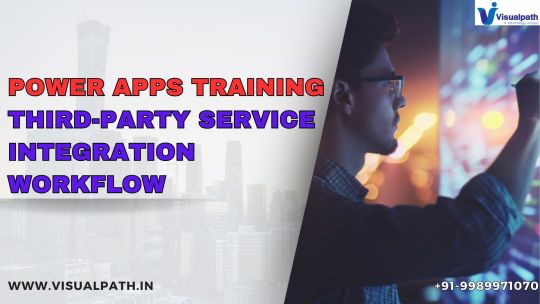
Understanding Power Automate Training for Seamless Integration
Integrating Power Apps with third-party services can be simplified using Power Automate. Power Automate Training enables users to automate repetitive tasks and workflows between different applications and services. For instance, you can connect Power Apps to services like SharePoint, Dynamics 365, Microsoft Teams, and even non-Microsoft services such as Salesforce, Dropbox, and Twitter.
When integrating third-party services, Power Automate acts as a bridge that automates tasks triggered by actions in Power Apps. For example, if you use Power Apps to capture data from users, Power Automate can be used to send that data to an external service, store it, or trigger another action. With the knowledge from Power Automate Training, you can configure these integrations without writing complex code.
Key Benefits of Power Apps Online Training for Third-Party Integrations
Completing Power Apps Online Training ensures that you understand how to connect your apps with multiple services using built-in connectors. There are over 500 connectors available in Power Apps, making it easy to integrate with both Microsoft and non-Microsoft platforms. Here are some key benefits of integrating Power Apps with third-party services:
Simplified Workflows: With connectors, Power Apps simplifies the process of integrating data and services. Users can quickly create apps that pull in information from multiple sources, such as databases, CRM systems, and file storage services.
Cost-Effective: Integration using Power Apps and Power Automate eliminates the need for custom APIs or heavy development efforts, saving both time and costs associated with traditional software development.
Scalability: Once you integrate Power Apps with third-party services, scaling becomes easier as connectors allow you to automate and manage larger volumes of data across multiple platforms.
Flexibility: With Power Apps Online Training, users can build apps tailored to specific business needs, ensuring that the integrations meet the unique requirements of your organization.
Steps to Integrate Power Apps with Third-Party Services
Choose a Connector: Start by selecting a connector that links Power Apps with the service you want to integrate. For example, if you are integrating with Salesforce, choose the Salesforce connector.
Set up a Flow in Power Automate: After selecting the connector, navigate to Power Automate and create a flow that triggers actions based on inputs from Power Apps. For instance, if a form is submitted in Power Apps, the flow can automatically save that data in Salesforce or any other integrated service.
Configure Permissions: Ensure that the third-party service has the correct permissions to access and interact with Power Apps. This may involve setting up OAuth authentication or API tokens.
Test and Monitor: Once the integration is set up, test it thoroughly. Use Power Automate to monitor the flow’s performance and ensure that the data is flowing correctly between Power Apps and the third-party service.
Best Practices for Learning Integration via Microsoft Power Apps Training Courses
Mastering the integration of Power Apps with third-party services requires continuous learning and hands-on practice. Enrolling in Microsoft Power Apps Training Courses will help you stay updated on new features, connectors, and integration techniques. Here are some best practices to keep in mind:
Start with Simple Integrations: Begin by integrating Power Apps with familiar services like Microsoft 365 or SharePoint. This will help you grasp the basics before moving on to more complex third-party services.
Use Pre-Built Templates: Microsoft Power Apps Training Courses often provide templates for common integrations. Use these templates to save time and ensure best practices are followed during the setup process.
Optimize Data Flow: When integrating with third-party services, ensure that the data flow is optimized. This means minimizing latency and ensuring that the app is not overloaded with unnecessary data transactions.
Security and Compliance: Always ensure that your integrations adhere to your organization's security policies. Protect sensitive data by using encryption and secure API connections.
Conclusion
Integrating Power Apps with third-party services is a powerful way to streamline workflows, automate tasks, and enhance business operations. By combining the knowledge from Power Apps Training with Power Automate Training, you can easily set up these integrations without the need for complex development work. Whether you are connecting Power Apps with Microsoft tools like Dynamics 365 or third-party platforms like Salesforce, the flexibility and ease of use provided by Power Apps and Power Automate ensure that your integrations are seamless and efficient.
To fully harness the potential of these tools, consider enrolling in Power Apps Online Training or Microsoft Power Apps Training Courses to gain hands-on experience and stay updated with the latest integration techniques. The skills you acquire will not only simplify third-party integrations but also empower you to create more dynamic, automated solutions for your business.
Visualpath is the Leading and Best Institute for learning in Hyderabad. We provide Power Apps and Power Automate Training. You will get the best course at an affordable cost.
Attend Free Demo
Call on – +91-9989971070
Visit: https://www.visualpath.in/online-powerapps-training.html
#Power Apps Training#Power Automate Training#Power Apps Online Training#Microsoft Power Apps Training#PowerApps Training Course#Power Apps and Power Automate Training#Power Apps Training in Hyderabad#Microsoft Power Apps Training Courses
1 note
·
View note
Text
Understanding Salesforce Community Cloud: Empowering Customer and Partner Engagement
Salesforce Community Cloud, now known as Experience Cloud Salesforce, is a powerful platform to create branded communities for the organization. Whether it’s connecting with customers, partners, or employees, Experience Cloud Salesforce offers a versatile and customizable solution for fostering engagement and collaboration. This article will explore what Salesforce Community Cloud is, its key features, and the benefits it brings to organizations.
What is Salesforce Community Cloud?
Salesforce Community Cloud is a digital experience platform that enables organizations to build customized, branded communities for different stakeholders. It serves as a hub where users can interact, find information, collaborate on projects, and engage with the brand. With Community Cloud, businesses can create portals, forums, and websites that are fully integrated with Salesforce CRM, providing a seamless experience for users.this is what is Salesforce community cloud is
Key Features of Salesforce Community Cloud
Customizable User Experiences: Salesforce Community Cloud allows businesses to create tailored experiences for different types of users, including customers, partners, and employees. With drag-and-drop tools and pre-built templates, organizations can design communities that reflect their brand and meet specific user needs.
Seamless Integration with Salesforce: One of the key strengths of Community Cloud is its deep integration with Salesforce CRM. This integration allows data to flow effortlessly between Salesforce and the community, ensuring that users have access to the most up-to-date information. For example, sales teams can share real-time data with partners, or customer service teams can resolve issues faster by leveraging insights from the CRM.
Enhanced Collaboration and Communication: Experience Cloud provides tools for discussion forums, file sharing, and collaboration, enabling users to work together effectively. Whether it’s partners collaborating on a joint business plan or customers engaging in a support forum, the platform fosters communication and strengthens relationships.
Personalized Content and Recommendations: Experience Cloud leverages AI to deliver personalized content and recommendations to users. This helps in providing a more relevant and engaging experience, increasing user satisfaction and retention. For instance, customers can receive tailored product recommendations based on their browsing history, or partners can access customized training materials relevant to their roles.
Robust Analytics and Reporting: Salesforce Community Cloud includes powerful analytics tools that allow businesses to track user engagement, identify trends, and measure the success of their communities. These insights help organizations make data-driven decisions to enhance user experiences and achieve their business goals.
Benefits of Salesforce Community Cloud
Improved Customer Engagement: By providing a dedicated space for customers to interact with your brand and each other, Salesforce Community Cloud enhances customer engagement. This leads to improved customer satisfaction, loyalty, and advocacy, which are crucial for business growth.
Streamlined Partner Collaboration: For businesses that rely on partnerships, Community Cloud offers a centralized platform for managing partner relationships. Partners can access the resources they need, collaborate on deals, and receive support, all in one place. This leads to stronger partnerships and increased revenue opportunities.
Enhanced Employee Productivity: Internal communities built on Experience Cloud can improve employee productivity by providing easy access to resources, knowledge, and collaboration tools. Employees can share best practices, seek advice, and work together on projects, leading to a more connected and efficient workforce.
Cost-Effective and Scalable: Salesforce Community Cloud is a cost-effective solution that can scale with your business. As your needs grow, you can expand your community to include more users, add new features, and customize the experience without significant investment.
Accelerated Time-to-Market: Community Cloud enables businesses to launch their communities quickly with its pre-built templates and easy-to-use design tools. This accelerates time-to-market, allowing organizations to start reaping the benefits of enhanced engagement and collaboration sooner.
Conclusion
Salesforce Community Cloud, now known as Experience Cloud Salesforce, is a versatile platform that empowers businesses to create personalized, branded communities for customers, partners, and employees. With its robust features, seamless Salesforce integration, and focus on user engagement, Community Cloud offers a powerful solution for enhancing collaboration, driving growth, and delivering a superior digital experience. Whether you’re looking to improve customer support, streamline partner interactions, or boost employee productivity, Salesforce Community Cloud provides the tools you need to succeed.
0 notes
Text
Top Tips for Exporting Attachments from Salesforce Seamlessly
Efficiently exporting attachments from Salesforce is crucial for managing and transferring important files. This guide provides top tips to ensure a seamless export process. Start by familiarizing yourself with the different methods available, such as using Salesforce’s built-in tools or third-party applications. Utilize the Data Loader to handle bulk exports efficiently, and consider using the Salesforce Reports feature to filter and export specific attachments. Always verify your export settings to ensure that all relevant files are included and correctly formatted. For large volumes of attachments, split the export into smaller batches to prevent system overload. Additionally, regularly update your Salesforce instance to benefit from the latest features and security enhancements. By following these best practices, you can streamline your attachment exports, reduce errors, and improve overall efficiency. Whether you’re migrating data or archiving files, these tips will help you manage your Salesforce attachments with ease and confidence.
0 notes
Text
Beyond YYYY-MM-DD: A Comprehensive Look at Salesforce Data Loader Date Format Options

Table of Contents
Introduction
Understanding Salesforce Data Loader
Significance of Correct Date Formats
Default Date Format: YYYY-MM-DD
Other Date Format Options
Configuring Date Formats in Salesforce Data Loader
Best Practices for Using Date Formats
Handling Time Zones
Common Challenges and Solutions
Testing Date Formats
Automating Date Format Configuration
Advanced Date Format Customizations
Integrating Salesforce Data Loader with Other Tools
Maintaining Data Integrity
Tips for Preparing Your Files for Salesforce Data Loader
Final Words
FAQs
Salesforce is all about data management. It allows users to record, store, track, and analyze specific data sets that belong to customers catered by an organization and the organization itself. The data stored in specific Salesforce objects helps users provide personalized services to their customers and obtain valuable insights about various business processes.
This makes it important for every Salesforce user to manage their database with extreme precision and accuracy. You cannot afford to load incorrect or insufficient data into your systems as it may result in mismanagement of processes and faulty communication.
Understanding Salesforce Data Loader
Salesforce Data Loader is a data management tool for Salesforce users that helps them import and export data in bulk. It provides functions like inserting, updating, deleting, and exporting Salesforce records.
For importing data, Data Loader reads, extracts, and loads data either from CSV (comma-separated values) files or from a database connection. For exporting data, the tool outputs CSV files to the specified location.
Salesforce Data Loader can be used in two ways – through the user interface and the command line. The user interface is interactive for specifying parameters, CSV files for import/export, and field mappings. The command line specifies configuration, mappings, data sources, and actions in files for automated data processing.
Significance of Correct Date Formats
Correct date formats are crucial in data accuracy. Incorrect date formats can lead to data inconsistency and misinterpretation. Proper date formats ensure data integrity and relevance over time.
Default Date Format: YYYY-MM-DD
The default date format in Salesforce Data Loader is YYYY-MM-DD. This format is straightforward and prevents confusion, ensuring consistency across records.
Other Date Format Options
Salesforce Data Loader supports various date formats, including:
MM/DD/YYYY (e.g., 08/12/2019)
DD/MM/YYYY (e.g., 14/11/2019)
YYYY/MM/DD (e.g., 2020/12/06)
Military Time Zones – MM/DD/YYYYThh:mm.mmmZ (e.g., 12-05-2019T12:04:12.000Z)
3 Letters Time Zones plus Offset – MM/DD/YYYYThh:mm.mmmXXX+hh(e.g., 04/12/2019T12:04:12.000GMT+03:00)
3 Letters Time Zones – MM/DD/YYYYThh:mm.mmmXXX (e.g., 05/22/2019T12:04:12.000GMT)
3 Letters Time Zones – YYYY-MM-DDThh:mm.mmmXXX (e.g., 2019-11-09T12:04:12.000GMT)
Configuring Date Formats in Salesforce Data Loader

To change your Salesforce Data Loader date format, go to Settings and select “Date/Time” for setting your date format and time zone.
Best Practices for Using Date Formats
Choose the right format: Select the format that best suits your business needs.
Ensure consistency: Maintain the same format across all records.
Test formats: Validate date formats before data migration.
Handling Time Zones
Time zones play a significant role in date formatting. Configure time zones in Salesforce Data Loader to ensure date accuracy across different regions.
Common Challenges and Solutions
Incorrect Date Imports: Sometimes, Data Loader imports dates incorrectly by converting them to GMT. Prevent this by setting the correct time zone and using the native time zone in CSV files.
Testing Date Formats
Test and validate date formats before data migration using tools and methods to ensure data accuracy.
Automating Date Format Configuration
Automate date format settings for large-scale data migrations to save time and reduce errors.
Advanced Date Format Customizations
Implement custom date formats in Salesforce Data Loader for more specific requirements. Customize formats according to business needs.
Integrating Salesforce Data Loader with Other Tools
Ensure seamless integration of date formats with other data management tools for better compatibility and efficiency.
Maintaining Data Integrity
Maintain data integrity with regular audits and checks to ensure the accuracy and consistency of date formats in Salesforce Data Loader.
Tips for Preparing Your Files for Salesforce Data Loader
Ensure CSV format: Convert files to CSV before uploading.
Check for corruption: Open and validate CSV files after conversion.
Avoid empty columns: Ensure no empty columns or duplicate headers.
Populate required fields: Ensure all system-required fields are populated.
Use conditional formatting: Highlight duplicate values in Excel before conversion.
Reapply formatting: Apply and save formatting in CSV files before importing.
Format phone numbers: Use Excel’s phone number format for phone and fax columns.
Validate email addresses: Ensure all email addresses are correctly formatted.
Remove currency symbols: Get rid of symbols and commas in number and currency columns.
Use correct checkbox values: Use “1” or TRUE for checked and “0” or FALSE for unchecked cells.
No multiple columns into one field: Data Loader does not support importing multiple columns into a single Salesforce field.
Address field support: Check the Salesforce Help topic for importing multiple street addresses.
Final Words
Data management in Salesforce should never be taken lightly. By considering these aspects before loading your data into Salesforce, Data Loader will help you sail through seamlessly. Techila Global Services provides the best solutions for Salesforce Data Loader Date Format.
FAQs
What is Salesforce Data Loader? Salesforce Data Loader is a tool for bulk data import and export in Salesforce.
What date formats does Salesforce Data Loader support? It supports formats like MM/DD/YYYY, DD/MM/YYYY, YYYY/MM/DD, and more.
How can I change the date format in Salesforce Data Loader? Go to Settings and select “Date/Time” for setting your date format and time zone.
Why are my date fields importing incorrectly? Data Loader may convert dates to GMT; set the correct time zone and use the native time zone in CSV files.
What are the best practices for using date formats in Data Loader? Choose the right format, ensure consistency, and test formats before data migration
1 note
·
View note
Text
Dell Boomi ETL

Dell Boomi: A Versatile Tool for ETL Processes
ETL, or Extract, Transform, and Load, is the central backbone of data management and analytics. When your business thrives on making data-driven decisions, efficient and reliable ETL practices are crucial. Dell Boomi, a leading iPaaS (Integration Platform as a Service), offers a robust suite of capabilities that excel at building out your ETL operations.
Why Dell Boomi for ETL?
Here’s why Dell Boomi stands out as a compelling choice for your ETL workflows:
Cloud-Based Simplicity: Boomi’s cloud-native design eliminates the complexities of managing on-premises ETL infrastructure. It’s a low-code, drag-and-drop platform, minimizing the need for extensive coding expertise.
Wide-Ranging Connectors: Effortlessly connect to diverse data sources, such as databases, cloud applications (like Salesforce or Workday), file formats (CSV, XML, etc.), messaging systems, and more. Boomi’s pre-built connectors streamline the process.
Powerful Transformations: Manipulate your data with ease. Boomi provides rich data transformation tools for cleansing, filtering, mapping, joining, and aggregating data, ensuring it’s tailored precisely for your target systems.
Scalability: ETL with Boomi can handle simple data transfers and extensive, complex data flows. It scales seamlessly to meet your evolving data needs.
Error Handling and Monitoring: Boomi offers built-in error handling, reporting, and real-time monitoring to help you identify and quickly resolve any issues within your ETL processes.
Critical Considerations for Using Boomi as an ETL Tool
Data Volumes and Complexity: Boomi is an excellent option for basic ETL needs. However, a traditional ETL tool might have a slight performance edge if you’re dealing with highly complex transformations or massive data volumes.
Data Warehousing: Boomi seamlessly integrates with data warehouses, allowing you to load transformed data directly into your analytical platforms.
Master Data Management (MDM): Boomi’s MDM capabilities complement ETL processes, enabling you to create a centralized, trusted master data repository for enhanced consistency and quality.
Getting Started with Boomi ETL
Plan Your ETL Process: Thoroughly map your data sources, required transformations, and target destinations. This will provide a clear blueprint for building your integrations.
Familiarize Yourself with Boomi: Explore Boomi’s interface, drag-and-drop components, connectors, and transformation functions.
Build Your First Integration: Start with a simple ETL flow, gradually progressing to more complex transformations.
Test and Monitor: Meticulously test your integrations to ensure accuracy. Regularly monitor your ETL processes within Boomi to address any issues proactively.
In Conclusion
Dell Boomi provides a powerful platform for both simple and advanced ETL requirements. Its user-friendliness, cloud-based architecture, and diverse connectivity options make it a favorite among organizations seeking to streamline their data integration and analysis. Dell Boomi is well worth considering if you’re looking for an ETL solution that prioritizes ease of use and scalability.
youtube
You can find more information about Dell Boomi in this Dell Boomi Link
Conclusion:
Unogeeks is the No.1 IT Training Institute for Dell Boomi Training. Anyone Disagree? Please drop in a comment
You can check out our other latest blogs on Dell Boomi here – Dell Boomi Blogs
You can check out our Best In Class Dell Boomi Details here – Dell Boomi Training
Follow & Connect with us:
———————————-
For Training inquiries:
Call/Whatsapp: +91 73960 33555
Mail us at: [email protected]
Our Website ➜ https://unogeeks.com
Follow us:
Instagram: https://www.instagram.com/unogeeks
Facebook: https://www.facebook.com/UnogeeksSoftwareTrainingInstitute
Twitter: https://twitter.com/unogeek
0 notes
Text
Maximizing Collaboration with Microsoft Teams - A Comprehensive Guide
With the rise of remote work and distributed teams, having the right tools and strategies in place to facilitate collaboration has become more critical than ever. Microsoft Teams emerges as a leading platform, offering a comprehensive suite of features designed to streamline communication, enhance teamwork, and maximize collaboration across all levels of an organization.
Why Microsoft Teams? Microsoft Teams is more than just a messaging or video conferencing platform; it's a robust collaboration hub that brings together chat, meetings, calling, file sharing, and app integration into a single, unified workspace. Whether your team is working remotely, in the office, or a combination of both, Microsoft Teams provides the flexibility and functionality needed to stay connected and productive.
Key Features and Functionality
Chat and Messaging: Instantly message individuals or create group chats for real-time communication. Share files, links, and multimedia content directly within the chat interface. Utilize emojis, gifs, and stickers to add personality and engagement to conversations.
Meetings and Video Conferencing: Host virtual meetings with audio, video, and screen sharing capabilities. Schedule and manage meetings directly within Teams, integrating with Outlook calendars. Collaborate in real-time on documents and presentations during meetings.
Calling: Make and receive calls directly within Microsoft Teams using VoIP technology. Seamlessly transition between chat, meetings, and calls within the same interface. Leverage advanced calling features such as call forwarding, voicemail, and call queues.
File Sharing and Collaboration: Store, access, and share files securely within Teams using OneDrive and SharePoint integration. Collaborate on documents in real-time using Office 365 apps like Word, Excel, and PowerPoint. Track document versions, comments, and edits to ensure seamless collaboration.
App Integration: Extend the functionality of Teams by integrating with third-party apps and services. Access tools like Trello, Asana, and Salesforce directly within the Teams interface. Create custom workflows and automate tasks using Microsoft Power Platform. Maximizing Collaboration with Microsoft Teams To maximize collaboration with Microsoft Teams, consider the following best practices:
Create a Collaborative Culture: Encourage open communication, knowledge sharing, and teamwork among team members.
Establish Clear Communication Channels: Define channels for different projects, departments, or topics to keep discussions organized and accessible.
Utilize Collaboration Tools: Take advantage of Teams' chat, meetings, calling, and file sharing features to facilitate collaboration across teams and locations.
Enable Remote Work: Provide remote workers with the tools and resources they need to stay connected and productive, regardless of their location.
Promote Training and Adoption: Offer training sessions and resources to help team members become proficient in using Teams' features and functionalities.
Monitor and Adjust: Regularly assess the effectiveness of collaboration efforts within Teams and make adjustments as needed to optimize workflows and communication.
By embracing Microsoft Teams as a central hub for collaboration, organizations can unlock new levels of productivity, innovation, and success. From real-time messaging to virtual meetings and file sharing, Teams offers a comprehensive suite of tools designed to empower teams to collaborate effectively, regardless of their location or working preferences.
Maximizing collaboration is essential for driving organizational success. With Microsoft Teams, organizations can create a collaborative environment that fosters communication, teamwork, and innovation. By leveraging Teams' comprehensive features and functionalities, teams can collaborate seamlessly, regardless of their location or working preferences. Embrace the power of Microsoft Teams and unlock new possibilities for collaboration in your organization today!
0 notes
Text
Best Salesforce course in Hyderabad
Salesforce is a cloud-based customer relationship management (CRM) platform that allows businesses to manage their sales, marketing, and customer service operations efficiently. A Salesforce course typically covers the fundamentals of using the Salesforce platform to customize and automate business processes, manage customer data, and optimize sales strategies.
Here's a comprehensive description of a typical Salesforce course along with its prerequisites:
Course Description:
The Salesforce course is designed to equip participants with the skills and knowledge required to effectively utilize the Salesforce platform for various business functions. The course typically covers the following topics:
Introduction to Salesforce: Understanding the basics of Salesforce, its features, and its role in CRM.
Navigating the Salesforce Interface: Learning how to navigate the Salesforce interface, including dashboards, reports, and record layouts.
Customization: Exploring how to customize Salesforce to meet specific business needs, including creating custom objects, fields, and page layouts.
Automation: Understanding how to automate business processes using Salesforce workflows, process builder, and flow.
Data Management: Learning best practices for importing, exporting, and managing data within Salesforce.
Security and Access Control: Implementing security measures to control access to data and features within Salesforce.
Integration: Integrating Salesforce with other applications and systems to streamline business processes.
Salesforce Lightning: Exploring the Salesforce Lightning interface and its features for enhanced user experience and productivity.
Reporting and Analytics: Creating and analyzing reports and dashboards to gain insights into sales performance and customer behavior.
AppExchange: Understanding how to leverage the Salesforce AppExchange marketplace to extend the functionality of Salesforce with third-party apps and integrations.
Prerequisites:
While specific prerequisites may vary depending on the course provider and the level of the course (beginner, intermediate, or advanced), typical prerequisites for a Salesforce course may include:
Basic Computer Skills: Participants should have a basic understanding of computer operations, including using web browsers, navigating file systems, and using productivity software.
Familiarity with CRM Concepts: A basic understanding of customer relationship management (CRM) concepts is beneficial but not always required.
Business Understanding: An understanding of basic business processes and terminology can help participants better grasp how Salesforce is used in real-world scenarios.
Internet Access: Participants should have access to a computer with a stable internet connection to access the Salesforce platform and course materials.
Optional: Trailhead Experience: While not mandatory, having some experience with Salesforce Trailhead, Salesforce's free online learning platform, can be advantageous as it provides a foundational understanding of Salesforce concepts.
Overall, a Salesforce course is suitable for individuals looking to gain proficiency in using Salesforce for sales, marketing, customer service, or other business functions. Whether you're a sales professional, a business analyst, a system administrator, or an aspiring Salesforce developer, mastering Salesforce can open up numerous career opportunities in today's digital business landscape.
0 notes